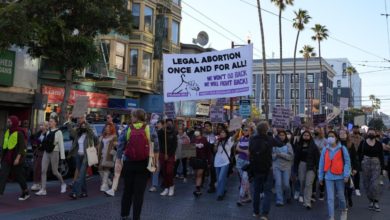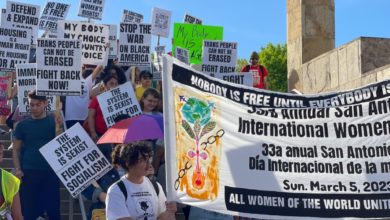Thousands marched in Juarez City, Mexico on May 27 against murders of women around the maquiladoras. Photo: Barbara Vazquez |
One unambiguous indicator of women’s place in society is the incidence of violence against women.
A global problem
Despite the many advances made by women over decades of struggle, violence against women remains pervasive worldwide. This violence cuts across culture, class, education, income, ethnicity and age. It may take the form of domestic abuse or murder. It may take the form of female infanticide, genital mutilation, dowry burning, sexual assault, kidnapping, murder, forced suicide of widows, honor killing, or rape within marriage. It takes place in the United States as well as in exploited countries like India or Mexico.
But in every case, violence against women is a vestige of women’s historic status as property—a product of the division of society into exploited and exploiting classes. It is a symptom of their continued subordinate status in class society. Global capitalism, far from solving the historic inequality of women, has incorporated violence against women into its business practices and its imperialist military strategies.
Worldwide, one out of three women has been beaten, forced into sex or abused in her lifetime. Up to 70 percent of female murder victims are killed by their male partners.
In the most oppressed countries, structural adjustment programs are forcing governments to privatize resources and eliminate social services. This has lead to increased inequality and an accompanying upsurge of violence against women.
For example, in the transnational sweatshops doing business under free trade agreements like NAFTA, young women working for slave wages are routinely abused at work. In a dramatic case, more than 300 girls and women have been killed since 1993 in Juarez, Mexico. Most were workers in the “maquiladora” factories in the free trade zone on the U.S.-Mexico border.
The formerly socialist countries in Eastern Europe have seen capitalism destroy their economic safety nets and shatter their many gains in gender equality. Sexist violence has been a dramatic result.
War causes massive suffering to women. Civilian casualties of today’s wars far outnumber those of armed combatants, and 80 percent of those are women and children. Women and girls are routinely the target of sexual violence, especially rape.
 Every year 200,000 women in the United States are victims of sexual violence. Photo: Bill Hackwell |
In the United States, men are more likely than women to be victims of violent crimes. But violence against women is specifically gender-based and often sexual. Every two minutes, somewhere in the United States, a woman is sexually assaulted and every six minutes one is raped. This amounts to about 200,000 victims per year.
It is estimated that only 40 percent of sexual assaults are reported to law enforcement. Many women prefer not to risk the shame, blame or indifference of law enforcement and the courts.
Since 1993, official statistics show a decline of nearly 50 percent in all violent crime. But that figure hides differences in crimes against men and women.
Crimes against men have decreased more sharply than those against women. In some areas, reports of sexual assault have risen. In New York City, for example, sexual assault cases rose 10 percent from 2001 to 2002. This is sometimes attributed to better reporting. But it is also important to understand how data are collected and reported by police departments.
In 2001, the Philadelphia Inquirer revealed that local police were misrepresenting rape complaints, leading to fewer investigations and lower rape statistics. The newspaper also raised concerns about police practices in four other cities. Since police reports are a source of federal data, the reliability of certain rape statistics is questionable.
The most vulnerable women are most often targets of violence. About half of all rape victims are poor, in the lowest third of income distribution. Women in prison suffer sexual assault, body searches, shackling during childbirth and rape by prison guards, few of whom are ever prosecuted. Women who don’t fit traditional gender roles, like lesbians and transgendered people, are especially vulnerable to attacks by police and prison officials.
The frequency of domestic violence
One of the main forms of violence against women is domestic violence—beatings and murder of women by their partners. In the privacy of the home, this remnant of property rights within marriage or the monogamous relationship lives on. It is a problem that affects not only the women who are attacked, but also children who are abused or witness the abuse.
The scale of domestic abuse in the United States is dramatic. A woman is battered by an intimate partner every 15 seconds. One-third of female murder victims are killed by an intimate partner. Sixty-four percent of women who are raped, assaulted or stalked are victimized by a current or former intimate partner.
More than three women are murdered by their husbands or boyfriends every day. Homicide is the leading cause of death for pregnant women. Thirty-one percent of U.S. women have been physically or sexually abused by an intimate partner at some point in their lives. Up to 14 percent of married women are raped by their husbands.
Violence against women affects poor women most severely. Those who work risk losing their jobs because of harassment or absenteeism. A disproportionate percentage of welfare recipients were domestic violence victims, many of whom used welfare as a means of gaining some economic independence from an abusive partner.
That was before welfare was gutted in 1996. The loss of this safety net has deprived women of a critical option for physical and economic survival. Poor women who flee their homes often become homeless, with no affordable housing available to them. Access to an independent income, childcare and transportation are among the primary needs for women who seek to escape violence at home.
Although women experience the vicious cycle of violence and poverty in isolation, it is not an individual problem. It is a social and political problem in a country whose ruling class has appropriated an increasing share of society’s wealth to enrich itself, deplete social services for workers and the poor and expand military conquest abroad.
Like other forms of violence against women, domestic violence is underreported to law enforcement. Not only do women fear reprisals, but they are also skeptical of police officers’ commitment to help them.
Domestic violence among cops, military
One reason for this mistrust may have to do with what is happening in more than a few officers’ homes. According to the National Center for Women and Policing, domestic violence is two to four times more prevalent among police families than among U.S. families in general—with 24 percent to 40 percent of women in police officer families experiencing domestic violence. Victims of a police officer are particularly vulnerable because the abuser has a gun, knows the location of battered women’s shelters and knows how to manipulate the legal system.
Nor is this due to individual “bad apples” in the police department. A 2003 incident in Los Angeles reveals that domestic violence by cops is officially tolerated. According to a report by the Feminist Majority Foundation, a criminal defense consultant leaked confidential files that revealed a pattern of domestic violence and cover-ups by officers in the Los Angeles Police Department. Of those accused of domestic violence, 29 percent were later promoted. Thirty percent were repeat offenders. But the whistle blower was jailed for contempt for leaking the files. Although the LAPD instituted some reforms after the incident was publicized, the case highlighted the institutional nature of anti-women violence within the state’s repressive institutions.
The same patterns of victimization of women can be seen in the military—another instrument of state repression. Despite a growing number of women in the military, there is a pervasive culture of hostility toward women that is promoted from the highest ranks of the officer corps. Widely publicized incidents like the 1991 Tailhook incident tell only part of the story.
A recent Pentagon report noted a 25 percent increase in the number of reported sexual assault cases with service member victims from 2003 to 2004, as well as a 41 percent increase from 2002 to 2004. Domestic violence rates in the military are two to three times higher than in the civilian population, with only a small proportion of violators prosecuted or disciplined. These crimes are most common among the elite special forces, including the four widely publicized 2002 murders of military wives at Fort Bragg, North Carolina.
This violence is above and beyond the violence against women civilians that occurs wherever U.S. armed forces are stationed, whether in U.S.-occupied Iraq or near U.S. military bases in Japan.
 The women’s liberation movement of the 1960s and 1970s won important reforms. Photo: Ron Innell/Toronto Star |
Following the mass women’s movement in the 1970s, women have won important reforms in the struggle against gender-based violence. Mass education and publicity campaigns have led to increased awareness of the issue and pressure on the legal, educational and health care system has produced significant remedies. Thousands of rape crisis centers, battered women’s shelters and domestic violence hotlines have been established; medical practitioners routinely screen female patients for abuse; and police receive mandated training in dealing with victims.
Legal changes include defining the degrees of sexual assault, eliminating the requirement for witnesses in sexual assault cases and excluding victims’ prior sexual history as evidence. In 1992 the National Council of Juvenile and Family Court Judges published model state codes on domestic violence.
Years of street action and intense lobbying for a federal law culminated in the 1994 passage of the Violence against Women Act. The law, which is up for reauthorization this year, brings national attention to gender-based crime and gives legitimacy to the issue in all government agencies.
Many states have coalitions, task forces or inter-agency programs dedicated to ending violence against women. In 1993 marital rape became a crime in all 50 states, under at least one section of the sexual offense codes. New York State has a “Domestic Violence Awareness Month,” and the attorney general’s office website shows an extensive list of rights and resources for women. This year New York State’s highest court ruled that women could not lose custody of their children solely because the children saw them being battered by abusive partners.
There have also been some steps forward for women internationally. The 1948 Universal Declaration of Human Rights had declared the equality of all human beings, including with respect to sex, and called for the prohibition of torture or degrading treatment. In 1993 the UN General Assembly passed the Declaration on the Elimination of Violence against Women, the first international human rights instrument to deal exclusively with violence against women. This was a model for other processes, such as the Inter-American Convention on the Prevention, Punishment and Eradication of Violence against Women, and the African Convention on Human and People’s Rights. The 1995 Fourth World Conference on Women in Beijing included elimination of all forms of violence against women as one of its twelve strategic objectives.
Of course, for all of these declarations, conditions for the vast majority of women in the world remain miserable.
Capitalism: a constant threat to reforms
But in a world economy dominated by capitalism—production for private profit—special oppression against women has an economic basis. Having whole groups of people subject to terror and insecurity in their personal lives erodes the possibilities for organizing for better living conditions—and, consequently, lower rates of profit.
So every legal gain made by women under capitalism is under constant attack. For every success, there is a setback.
For example, the Department of Housing and Urban Development now requires detailed information on battered women to be collected from domestic violence shelters that receive HUD funding. This information is computerized and available to other government agencies. Over 40,000 women each year use shelters financed by HUD.
The Personal Responsibility, Work and Family Promotion Act of 2005, now in the Senate, will spend $1.6 billion to “promote marriage” and force poor women to accept low-wage, dead-end jobs, leaving their children in inadequate childcare. The government is already spending over $100 million on marriage promotion, taking funds from other social programs.
These “marriage promotion” laws do nothing to provide the foundation for providing families with adequate wages, health care or childcare. Rather, they provide incentives for women to enter into relationships that may be abusive or unstable.
Anti-imperialism and the struggle against sexism
The sheer magnitude of the problem of violence against women around the world, including in the most advanced capitalist countries, shows that it is not a random or an individual crime. It is a tool of oppression that keeps women subordinate.
Ideologically, sexist violence in the United States—the most advanced capitalist state in the world—is a symbol of the glorification of war, violence and the male “hero” that pervades U.S. culture. Imperialist expansion and war have intensified the exploitation and suffering of women here and in other countries.
The women’s movement has won important reforms in the political, economic and social spheres. Every victory was won because women and their allies took to the streets and lit a fire under legislatures, courts and police.
The causes of women’s oppression are rooted in class society. The ongoing struggle for women’s equality and freedom from violence is an international one, integral to the struggle against imperialism and war. The renewal of activism in response to the Iraq war and capitalist globalization presents an excellent opportunity to unite in fighting women’s oppression, capitalist exploitation and militarism.






